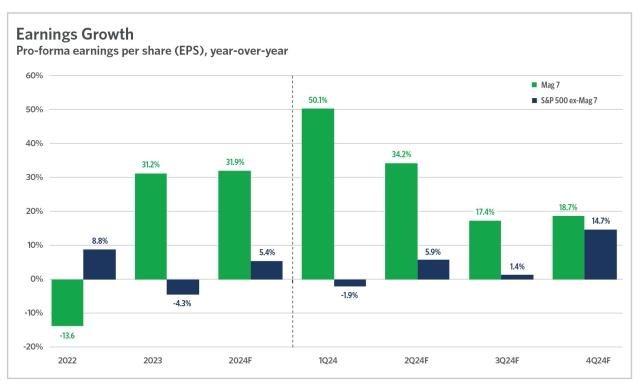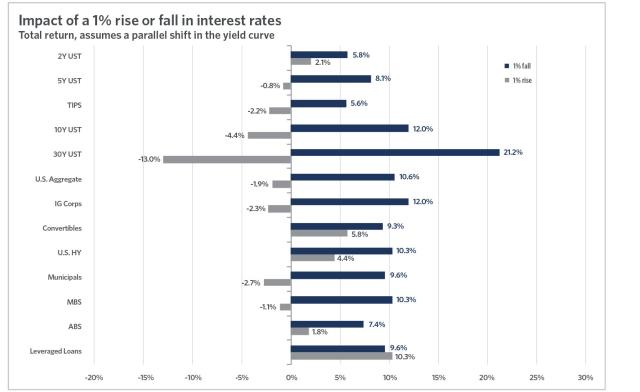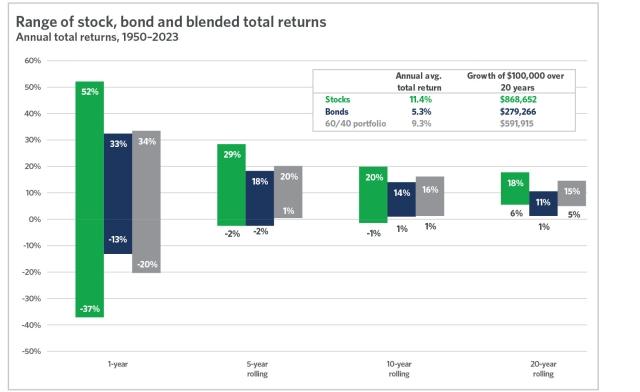In this article, we review:
- The current economic landscape and its potential headwinds
- Investment opportunities in undervalued sectors such as semiconductors outside of AI, rail and parcel, and home improvement
- The potential benefits of a diversified portfolio, including a long-term, 60/40 investment strategy that blends stocks and bonds
After accelerating into the back half of 2023, the U.S. economy has begun to slow. Over the short term, potential headwinds such as high policy rates, cost pressures, and geopolitical uncertainty will weigh on corporate and consumer confidence. Still, looking forward, significant fiscal spending, particularly on infrastructure (such as the Inflation Reduction Act and the Creating Helpful Incentives to Produce Semiconductors and Science Act), coupled with growing enthusiasm for generative artificial intelligence (AI), should provide an accommodative backdrop for strong secular growth. Moreover, easing wage pressure, cooling inflation, and lower interest rates may result in a better environment for a 60/40 blended portfolio of stocks and bonds.
Equity markets don’t seem to have fully priced in this prognosis, reflected in the narrow nature of the market rally. The Magnificent Seven1 have outperformed the rest of the market, up over 30% since the start of the year compared to under 10% for the remaining companies. As a result, valuations for the so-called “S&P 493” remain depressed relative to the broader market. These names could therefore be thought of as “coiled springs.”
While this potential opportunity set is broad and, in many ways, transcends the style-box spectrum, value names, particularly those with an exposure to the goods portion of the economy, may be particularly interesting. Some examples of this include:
- Semiconductors: Within this cyclical industry, depressed areas like automobiles, personal electronics, communications, and enterprise may soon bounce back as demand is reinvigorated off low levels left behind by pandemic “over-ordering,” underscoring that semiconductor opportunities exist outside of AI.
- Rail and parcel: Strong wage growth and recession fears acted as headwinds to freight, but unexpected economic resiliency and the growing need to move materials associated with fiscal stimulus and AI may be a catalyst for outperformance. Automation has also significantly improved efficiencies.
- Home improvement: Higher interest rates and COVID-19-era renovations have reduced demand for capital investment at home. However, with the average U.S. home age increasing, the likelihood of significant maintenance expenditures has gone up. Moreover, labor-related backlogs in older projects are clearing as immigration has helped solve labor shortages.
As a result, while the U.S. equity market may seem unapproachable at first blush — thanks to stretched valuations and all-time-high prices in the S&P 500® — savvy investors can stay constructive in the near term by remembering that the opportunity set extends beyond a small handful of names.
At the same time, long-term investors should embrace a more holistic view of portfolio construction. This can be reflected through an allocation to growth equity, including some of the names in the Magnificent Seven. After all, technology is a secular trend, and the U.S. has a competitive advantage in the sector with a proven track record of innovation. It can also be reflected through an allocation to fixed income: Falling interest rates should provide a duration tailwind for bonds, but a healthy U.S. economy should keep rates meaningfully above zero. This will result in a better backdrop for fixed income than seen in several decades, particularly for those investors holding short-to-intermediate duration, high-quality instruments.
Source: FactSet, Standard & Poor’s, J.P. Morgan Asset Management. Data are as of August 21, 2024. Magnificent 7 includes AAPL, AMZN, GOOG/GOOGL, META, MSFT, NVDA and TSLA. Earnings estimates for 2024 are forecasts based on consensus analyst expectations. Guide to the Markets – U.S. Data are as of August 21, 2024.
Source: Bloomberg, FactSet, Standard & Poor’s, U.S. Treasury, J.P. Morgan Asset Management. Sectors shown above are provided by Bloomberg unless otherwise noted and are represented by – U.S. Aggregate; MBS: U.S. Aggregate Securitized - MBS; ABS: J.P. Morgan ABS Index; IG Corporates: U.S. Corporates; Municipals: Muni Bond; High Yield: Corporate High Yield; Leveraged Loans: J.P. Morgan Leveraged Loan Index; TIPS: Treasury Inflation-Protected Securities; Convertibles: U.S. Convertibles Composite. Convertibles yield is as of most recent month-end and is based on U.S. portion of Bloomberg Global Convertibles Index. Yield and return information based on bellwethers for Treasury securities. Yields shown for TIPS are real yields. Sector yields reflect yield-to-worst. Leveraged loan yields reflect the yield to 3Y takeout. ABS returns prior to June 2012 are sourced from Bloomberg. Past performance is not indicative of future results. This above is for informational purposes only based on assumptions and current market conditions and are subject to change.
Guide to the Markets – U.S. Data are as of August 21, 2024.
Source: Bloomberg, FactSet, Federal Reserve, Robert Shiller, Standard & Poor’s, Strategas/Ibbotson, J.P. Morgan Asset Management.
Returns shown are based on calendar year returns from 1950 to 2023. Stocks represent the S&P 500 Shiller Composite for periods prior to 1936 and the S&P 500 thereafter. Bonds represent Strategas/Ibbotson for periods prior to 1976 and the Bloomberg Aggregate thereafter. Growth of $100,000 is based on annual average total returns from 1950 to 2023 and is hypothetical. Guide to the Markets – U.S. Data are as of August 21, 2024. This chart is not intended to imply any future performance.
Ultimately, the investment environment is changing. As always, the best defense against this change is to diversify through a 60/40 portfolio with an emphasis on active management across stocks and bonds.
1 Magnificent Seven includes AAPL, AMZN, GOOG/GOOGL, META, MSFT, NVDA, and TSLA.
About the Author
Jack Manley, Executive Director, is a Global Market Strategist at J.P. Morgan Asset Management. Jack is responsible for delivering timely market and economic commentary to institutional and retail clients across the United States and Canada. In addition, he is a contributor to the J.P. Morgan Long-Term Capital Market Assumptions and has authored numerous papers on global economies and capital markets. Jack is also a frequent guest on BNN, Bloomberg, CNBC, and Fox Business, and is often quoted in the financial press. He graduated from the University of Chicago with a bachelor’s degree in history.
Related Funds
Transamerica Multi-Managed Balanced Fund
Index Definitions
The S&P 500® Index is a widely regarded gauge of large-cap U.S. equities. The index includes 500 leading companies and covers approximately 80% of available market capitalization.
The Bloomberg US Aggregate Bond Index is an unmanaged index used as a general measure of market performance.
The Bloomberg US Securitized – MBS Index tracks all USD-denominated, investment-grade, securitized issues within the US Aggregate Bond Index with a weighted average maturity of at least one year.
The Bloomberg US Corporate Index measures the investment-grade, fixed-rate, taxable corporate bond market.
The Bloomberg Municipal Bond Index is an unmanaged index considered representative of the broad market for investment-grade municipal bonds.
The Bloomberg US Corporate High Yield Bond Index measures the USD-denominated, high-yield, fixed-rate corporate bond market.
The Bloomberg Global Convertibles Composite Index is a multi-currency benchmark, which aims to track performance of all major classes of convertible securities globally.
The J.P. Morgan Asset Backed Securities Index (ABS) represents USD-denominated tradeable ABS instruments.
The J.P. Morgan Leveraged Loan Index is designed to mirror the investable universe of the USD institutional leveraged loan market.
Treasury Inflation-Protected Securities (TIPS) are a type of Treasury security, issued by the U.S. government, that is indexed to inflation.
Past performance is not indicative of future results. It is not possible to invest directly in an index, which also does not include the application of fees.
Important Information
All opinions, estimates, projections, and security selections contained herein are those of the sub-adviser. It does not constitute investment advice and should not be used as a basis for any investment decision.
Mutual funds are subject to market risk, including loss of principal. Past performance is not indicative of future results.
Mutual funds are sold by prospectus. Before investing, consider the funds' investment objectives, risks, charges, and expenses. This and other important information is contained in the prospectus. Please visit transamerica.com or contact your financial professional to obtain a prospectus or, if available, a summary prospectus containing this information. Please read it carefully before investing.
The price of equity securities fluctuates based on changes in a company's financial condition and overall market and economic conditions. If the market prices of the equity securities owned by the fund fall, the value of the fund will decline. Fixed-income securities are subject to risks including credit risk, interest rate risk, counterparty risk, prepayment risk, extension risk, valuation risk, and liquidity risk. The value of fixed income securities generally goes down when interest rates rise.
Transamerica Funds are advised by Transamerica Asset Management, Inc. (TAM) and distributed by Transamerica Capital, Inc. (TCI), member of FINRA.
Transamerica Companies and J.P. Morgan are not affiliated companies.
© 2024 Transamerica Corporation. All Rights Reserved.






